Fast Algorithm of Passive Bistatic Radar Detection Based on Batches Processing of Sparse Representation and Recovery
Abstract
1. Introduction
2. Signal Model
3. Fast Batches Processing of Sparse Representation and Recovery in Delay-Doppler Domain
3.1. Fast Batches Processing of Sparse Representation
- Compute CAF for reference signal and surveillance signal to obtain . Divide into equally sized blocks: .
- Transform the CAF blocks into vector form, denoted as .
- Compute the self ambiguity function for the reference signal to obtain . Crop to obtain CAF copies .
- Convert the CAF copies into vector form, i.e., .
- Join the vectorized CAF copies to obtain the measurement matrix .
- Use the measurement matrix to perform sparse recovery on the vectorized CAF blocks , to obtain sparse vectors .
- Convert the sparse vectors into matrix form, i.e., .
- Join the sparse matrices to obtain the sparse matrix corresponding to .
3.2. Target Detection Based on Sparse Recovery
4. Experimental Results
4.1. Simulation Results
4.2. Actual Test Results
4.3. Comparison Results of Calculation Amount
5. Conclusions
Author Contributions
Funding
Data Availability Statement
Acknowledgments
Conflicts of Interest
References
- Zheng, H.; Wang, J.; Jiang, S.; Wu, X.; Gu, X. Passive Bistatic Radar, 1st ed.; National Defense Industry Press: Beijing, China, 2017. [Google Scholar]
- Liu, R.; Dai, W.; Zhang, C. Multi-target Detection by Distributed Passive Radar Systems without Reference Signals. In Proceedings of the 2021 IEEE Wireless Communications and Networking Conference (WCNC), Nanjing, China, 29 March–1 April 2021; pp. 1–5. [Google Scholar]
- Li, J.C.; Zhang, Y.D.; Zhang, Y.K.; Li, X.D. Direct Path Wave Purification for Passive Radar with Normalized Least Mean Square Algorithm. In Proceedings of the 2013 IEEE International Conference on Signal Processing, Communication and Computing (ICSPCC 2013), Kunming, China, 5–8 August 2013; pp. 1–4. [Google Scholar]
- Yang, P.C.; Lyu, X.D.; Chai, Z.H.; Zhang, D.; Yue, Q.; Yang, J.M. Clutter Cancellation Along the Clutter Ridge for Airborne Passive Radar. IEEE Geosci. Remote Sens. Lett. 2017, 14, 951–955. [Google Scholar] [CrossRef]
- Sui, J.; Wang, J.; Gao, J.; Fan, X. A Novel Strong Clutter Suppression Algorithm for Airborne Passive Radar. In Proceedings of the 2021 CIE International Conference on Radar (Radar), Haikou, China, 15–19 December 2021; pp. 2791–2794. [Google Scholar]
- Moscardini, C.; Petri, D.; Capria, A.; Conti, M.; Martorella, M.; Berizzi, F. Batches algorithm for passive radar: A theoretical analysis. IEEE Trans. Aerosp. Electron. Syst. 2015, 51, 1475–1487. [Google Scholar] [CrossRef]
- Rao, Y.; Nie, W.; Zhou, J. Fast Algorithm and Hardware Implementation of Ambiguity Function for Passive Radar. Syst. Eng. Electron. 2020, 42, 1953–1960. [Google Scholar]
- Park, G.H.; Seo, Y.K.; Kim, H.N. Range-Doppler Domain-Based DOA Estimation Method for FM-Band Passive Bistatic Radar. IEEE Access 2020, 8, 56880–56891. [Google Scholar] [CrossRef]
- Miao, Y.; Li, J.; Bao, Y.; Liu, F.; Hu, C. Efficient Multipath Clutter Cancellation for UAV Monitoring Using DAB Satellite-Based PBR. Remote Sens. 2021, 13, 3429. [Google Scholar] [CrossRef]
- Gómez-del-Hoyo, P.J.; Jarabo-Amores, M.P.; Mata-Moya, D.; del-Rey-Maestre, N.; Rosa-Zurera, M. DVB-T Receiver Independent of Channel Allocation, With Frequency Offset Compensation for Improving Resolution in Low Cost Passive Radar. IEEE Sens. J. 2020, 20, 14958–14974. [Google Scholar] [CrossRef]
- Zhang, X.; Yi, J.; Wan, X.; Liu, Y. Reference Signal Reconstruction Under Oversampling for DTMB-Based Passive Radar. IEEE Access 2020, 8, 74024–74038. [Google Scholar] [CrossRef]
- Li, J. A DVB-S-Based Multichannel Passive Radar System for Vehicle Detection. IEEE Access 2021, 9, 2900–2912. [Google Scholar] [CrossRef]
- Knoedler, B.; Steffes, C.; Koch, W. Detecting and Tracking a Small UAV in GSM Passive Radar Using Track-before-Detect. In Proceedings of the 2020 IEEE Radar Conference (RadarConf20), Florence, Italy, 21–25 September 2020; pp. 1–6. [Google Scholar]
- Zhang, C.; Shi, S.; Yan, S.; Gong, J. Moving Target Detection and Parameter Estimation Using BeiDou GEO Satellites-Based Passive Radar with Short-Time Integration. IEEE J. Sel. Top. Appl. Earth Obs. Remote Sens. 2023, 16, 3959–3972. [Google Scholar] [CrossRef]
- Zhang, Z.; Zheng, Y.; Zheng, L.; Zhu, P. Range Resolution and Sampling Frequency Trade-Off for GPS Passive Radar. J. Syst. Eng. Electron. 2022, 33, 28–37. [Google Scholar] [CrossRef]
- Tao, R.; Gao, Z.; Wang, Y. Side Peaks Interference Suppression in DVB-T Based Passive Radar. IEEE Trans. Aerosp. Electron. Syst. 2012, 48, 3610–3619. [Google Scholar] [CrossRef]
- Wang, T.; Liu, B.; Wang, X.; Xu, X.; Wei, Q. Passive radar analysis using DTMB signal. In Proceedings of the 2021 19th International Conference on Optical Communications and Networks (ICOCN), Qufu, China, 23–27 August 2021; pp. 1–3. [Google Scholar]
- Samczyński, P. 5G Network-Based Passive Radar. IEEE Trans. Geosci. Remote Sens. 2022, 60, 5108209. [Google Scholar] [CrossRef]
- Zhang, X.; Labeau, F.; Liang, Y.C.; Fang, J. Compressive Sensing-Based Multiuser Detection via Iterative Reweighed Approach in M2M Communications. IEEE Wirel. Commun. Lett. 2018, 7, 764–767. [Google Scholar] [CrossRef]
- Zhang, Y.; Xiang, Y.; Zhang, L.Y.; Rong, Y.; Guo, S. Secure Wireless Communications Based on Compressive Sensing: A Survey. IEEE Commun. Surv. Tutor. 2019, 21, 1093–1111. [Google Scholar] [CrossRef]
- Lu, L.; Xu, W.; Wang, Y.; Tian, Z. Compressive Spectrum Sensing Using Sampling-Controlled Block Orthogonal Matching Pursuit. IEEE Trans. Commun. 2023, 71, 1096–1111. [Google Scholar] [CrossRef]
- Chen, J.; Yang, J.G.; An, W.; Chen, Z.J. An Attitude Jitter Correction Method for Multispectral Parallax Imagery Based on Compressive Sensing. IEEE Geosci. Remote Sens. Lett. 2017, 14, 1903–1907. [Google Scholar] [CrossRef]
- Li, H.; Dai, F.; Zhao, Q.; Ma, Y.; Cao, J.; Zhang, Y. Non-uniform Compressive Sensing Imaging Based on Image Saliency. Chin. J. Electron. 2023, 32, 159–165. [Google Scholar] [CrossRef]
- Gan, H.; Shen, M.; Hua, Y.; Ma, C.; Zhang, T. From Patch to Pixel: A Transformer-Based Hierarchical Framework for Compressive Image Sensing. IEEE Trans. Comput. Imaging 2023, 9, 133–146. [Google Scholar] [CrossRef]
- Wei, S. 3DRIED: A High-Resolution 3-D Millimeter-Wave Radar Dataset Dedicated to Imaging and Evaluation. Remote Sens. 2021, 13, 3366. [Google Scholar] [CrossRef]
- Ajorloo, A.; Amini, A.; Amiri, R. A Joint Scheme of Antenna Placement and Power Allocation in a Compressive-Sensing-Based Colocated MIMO Radar. IEEE Sens. Lett. 2022, 6, 1–4. [Google Scholar] [CrossRef]
- Zhu, L.; Wen, G.; Liang, Y.; Luo, D.; Jian, H. Multitarget Enumeration and Localization in Distributed MIMO Radar Based on Energy Modeling and Compressive Sensing. IEEE Trans. Aerosp. Electron. Syst. 2023, 59, 4493–4510. [Google Scholar] [CrossRef]
- Berger, C.R.; Zhou, S.L.; Willett, P. Signal Extraction Using Compressed Sensing for Passive Radar with OFDM Signals. In Proceedings of the 2008 11th International Conference on Information Fusion, Cologne, Germany, 30 June–3 July 2008; pp. 1–6. [Google Scholar]
- Zheng, L.; Wang, X. Super-Resolution Delay-Doppler Estimation for OFDM Passive Radar. IEEE Trans. Signal Process. 2017, 65, 2197–2210. [Google Scholar] [CrossRef]
- Weiß, M. Compressive Sensing for Passive Surveillance Radar Using DAB Signals. In Proceedings of the 2014 International Radar Conference, Lille, France, 13–17 October 2014; pp. 1–6. [Google Scholar]
- Hadi, M.A.; Tabassum, M.N.; Alshebeili, S. Compressive Sensing Based High-Resolution Passive Bistatic Radar. Signal Image Video Process. 2017, 11, 635–642. [Google Scholar] [CrossRef]
- Nikaein, H.; Sheikhi, A.; Gazor, S. Target Detection in Passive Radar Sensors Using Least Angle Regression. IEEE Sens. J. 2021, 21, 4533–4542. [Google Scholar] [CrossRef]
- Xie, D.; Yi, J.; Wan, X.; Jiang, H. Masking Effect Mitigation for FM-Based Passive Radar via Nonlinear Sparse Recovery. IEEE Trans. Aerosp. Electron. Syst. 2023, 59, 8246–8262. [Google Scholar] [CrossRef]
- Feng, W.; Friedt, J.M.; Cherniak, G.; Sato, M. Batch Compressive Sensing for Passive Radar Range-Doppler Map Generation. IEEE Trans. Aerosp. Electron. Syst. 2019, 55, 3090–3102. [Google Scholar] [CrossRef]
- Yang, P.C.; Lyu, X.D.; Li, J.C. Target Detection for Passive Radar Using Compressive Sensing. Radar Sci. Technol. 2015, 13, 384–389. [Google Scholar]
- Yin, Q.; Yi, J.; Tang, J.; Zhu, Q. A Novel Orthogonal Matching Pursuit Algorithm based on Reduced-Dimension Dictionary for Airborne MIMO Radar. In Proceedings of the 2021 2nd International Symposium on Computer Engineering and Intelligent Communications (ISCEIC), Nanjing, China, 6–8 August 2021; pp. 202–206. [Google Scholar]
- Ding, J.; Wang, M.; Kang, H.; Wang, Z. MIMO Radar Super-Resolution Imaging Based on Reconstruction of the Measurement Matrix of Compressed Sensing. IEEE Geosci. Remote Sens. Lett. 2022, 19, 3504705. [Google Scholar] [CrossRef]
- Kulkarni, A.; Mohsenin, T. Low Overhead Architectures for OMP Compressive Sensing Reconstruction Algorithm. IEEE Trans. Circuits Syst. Regul. Pap. 2017, 64, 1468–1480. [Google Scholar]
- Vu, T.; Chunikhina, E.; Raich, R. On Local Linear Convergence Rate of Iterative Hard Thresholding for Matrix Completion. IEEE Trans. Signal Process. 2022, 70, 5940–5953. [Google Scholar]
- Cui, A.; He, H.; Xie, Z.; Yan, W.; Yang, H. Iterative Difference Hard-Thresholding Algorithm for Sparse Signal Recovery. IEEE Trans. Signal Process. 2023, 71, 1093–1102. [Google Scholar]
- Matsumoto, N.; Mazumdar, A. Binary Iterative Hard Thresholding Converges with Optimal Number of Measurements for 1-Bit Compressed Sensing. In Proceedings of the 2022 IEEE 63rd Annual Symposium on Foundations of Computer Science (FOCS), Denver, CO, USA, 31 October–3 November 2022; pp. 813–822. [Google Scholar]
- Liu, Y.; Zhan, Z.; Cai, J.F.; Guo, D.; Chen, Z.; Qu, X. Projected Iterative Soft-Thresholding Algorithm for Tight Frames in Compressed Sensing Magnetic Resonance Imaging. IEEE Trans. Med. Imaging 2016, 35, 2130–2140. [Google Scholar] [CrossRef] [PubMed]
- Kim, D.; Park, D. Element-Wise Adaptive Thresholds for Learned Iterative Shrinkage Thresholding Algorithms. IEEE Access 2020, 8, 45874–45886. [Google Scholar] [CrossRef]
- Chen, Y.; Sun, Y.; Liu, Q. Parametric Iterative Soft Thresholding Algorithm for Refocusing of Moving Targets in SAR Images. IEEE Trans. Geosci. Remote Sens. 2022, 60, 5229109. [Google Scholar] [CrossRef]
- Wang, C.; Che, J.; Zhou, F.; Hou, J.; Li, C. Single Snapshot DOA Estimation by Minimizing the Fraction Function in Sparse Recovery. Math. Probl. Eng. 2020, 2020, 6163529. [Google Scholar] [CrossRef]
- Del-Rey-Maestre, N.; Jarabo-Amores, M.P.; Bárcena-Humanes, J.L.; Mata-Moya, D.; Gómez-del-Hoyo, P. ECA Filter Effects on Ground Clutter Statistics in DVB- T Based Passive Radar. In Proceedings of the 2018 26th European Signal Processing Conference (EUSIPCO), Rome, Italy, 3–7 September 2018; pp. 1217–1221. [Google Scholar]
- Zhou, X.; Wang, P.; Chen, J.; Men, Z.; Liu, W.; Zeng, H. A Modified Radon Fourier Transform for GNSS-Based Bistatic Radar Target Detection. IEEE Geosci. Remote Sens. Lett. 2022, 19, 3501805. [Google Scholar] [CrossRef]

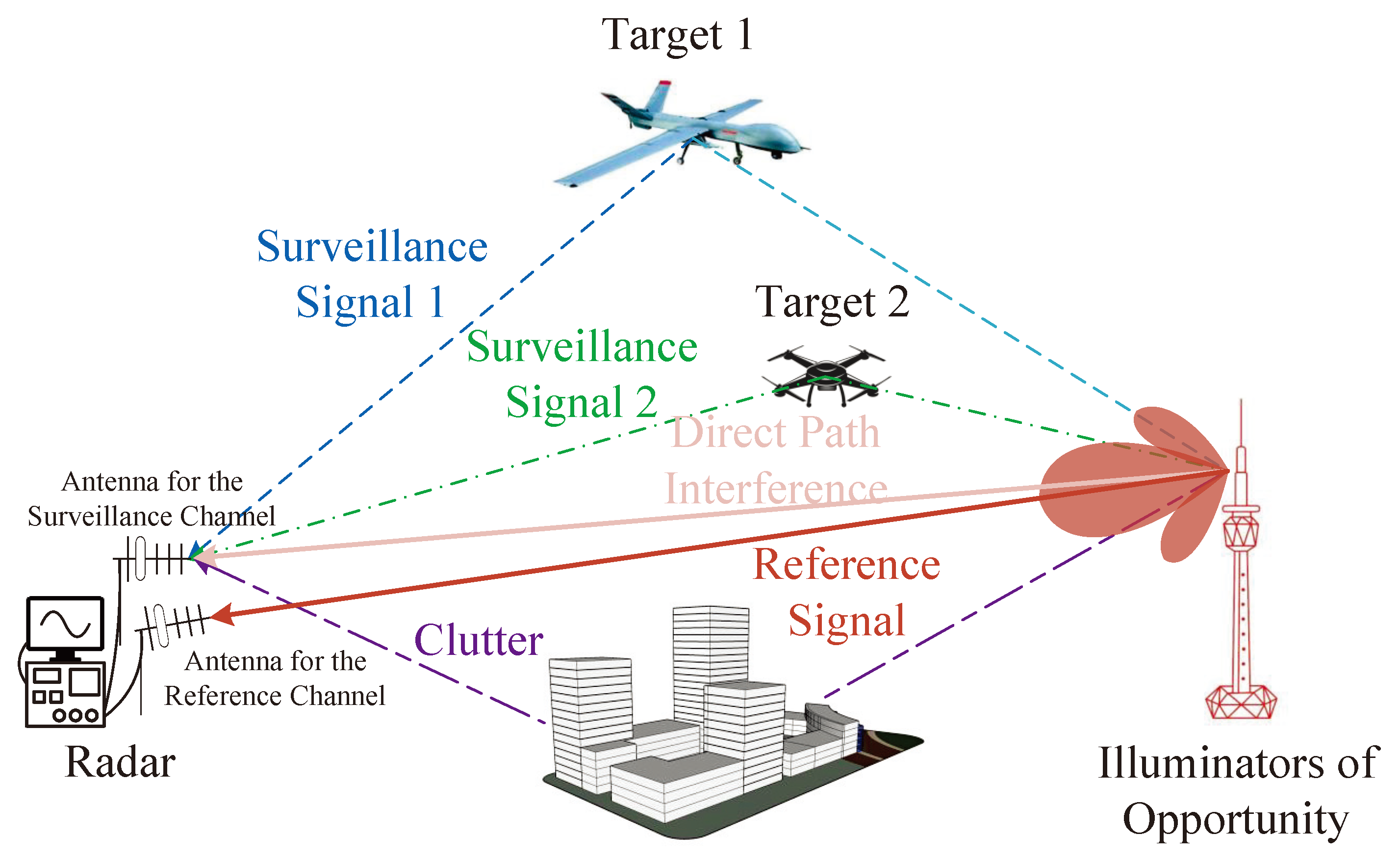
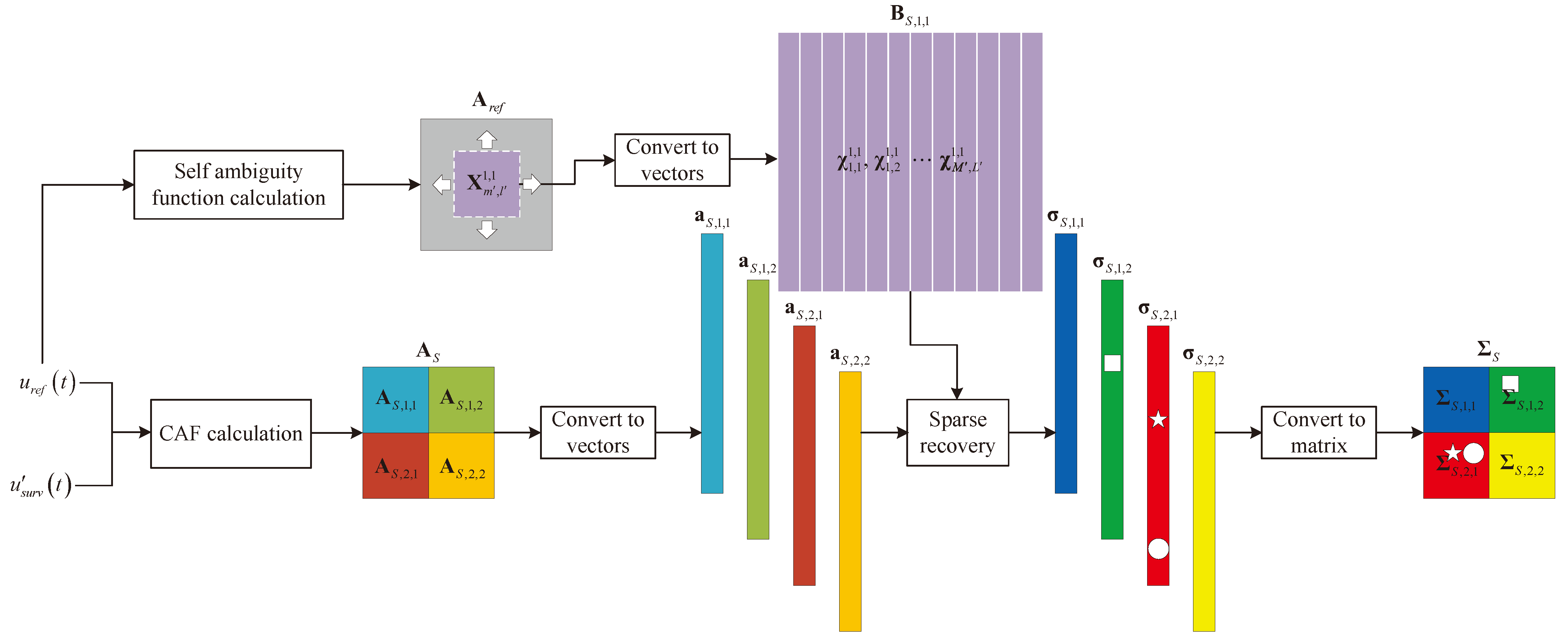

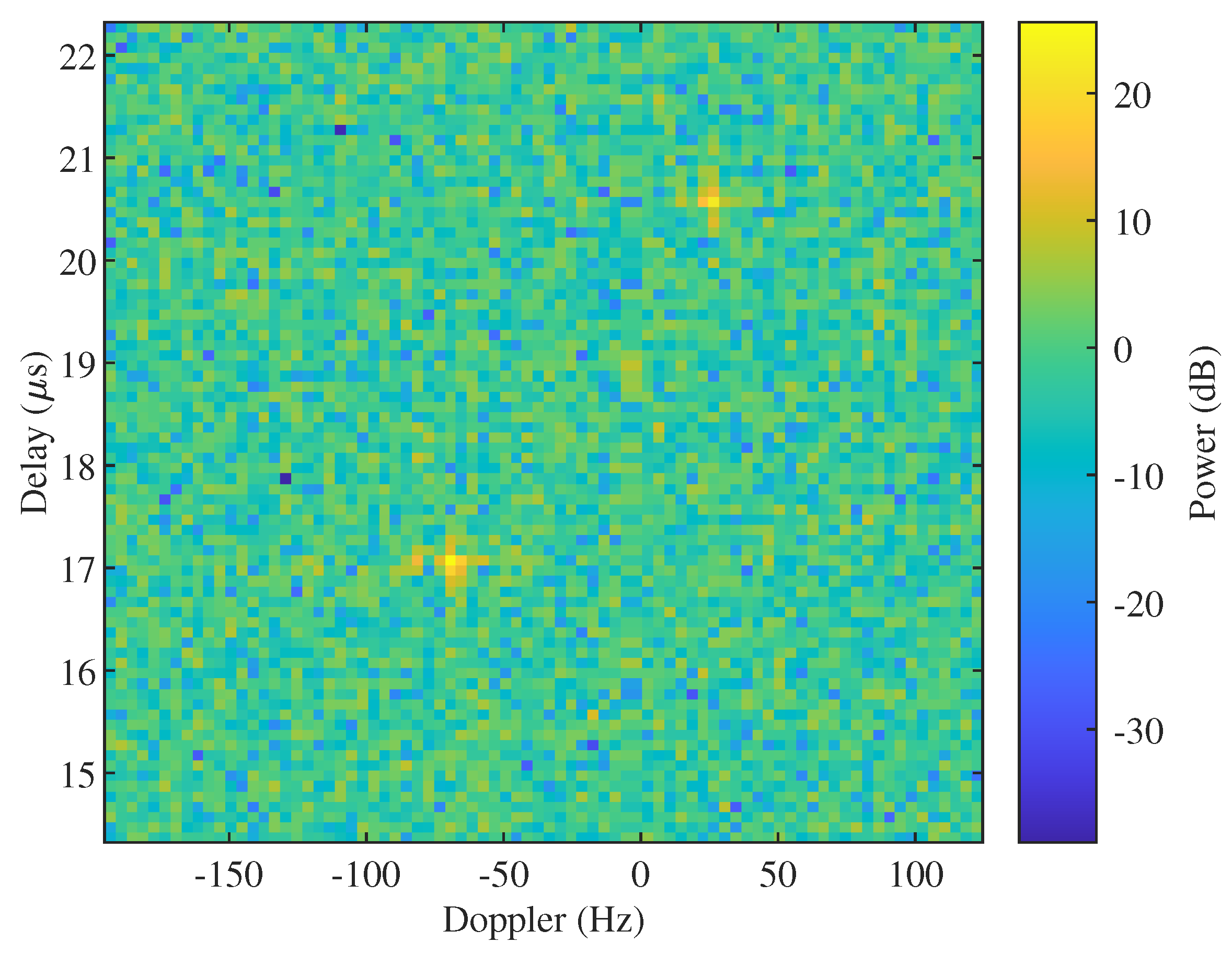



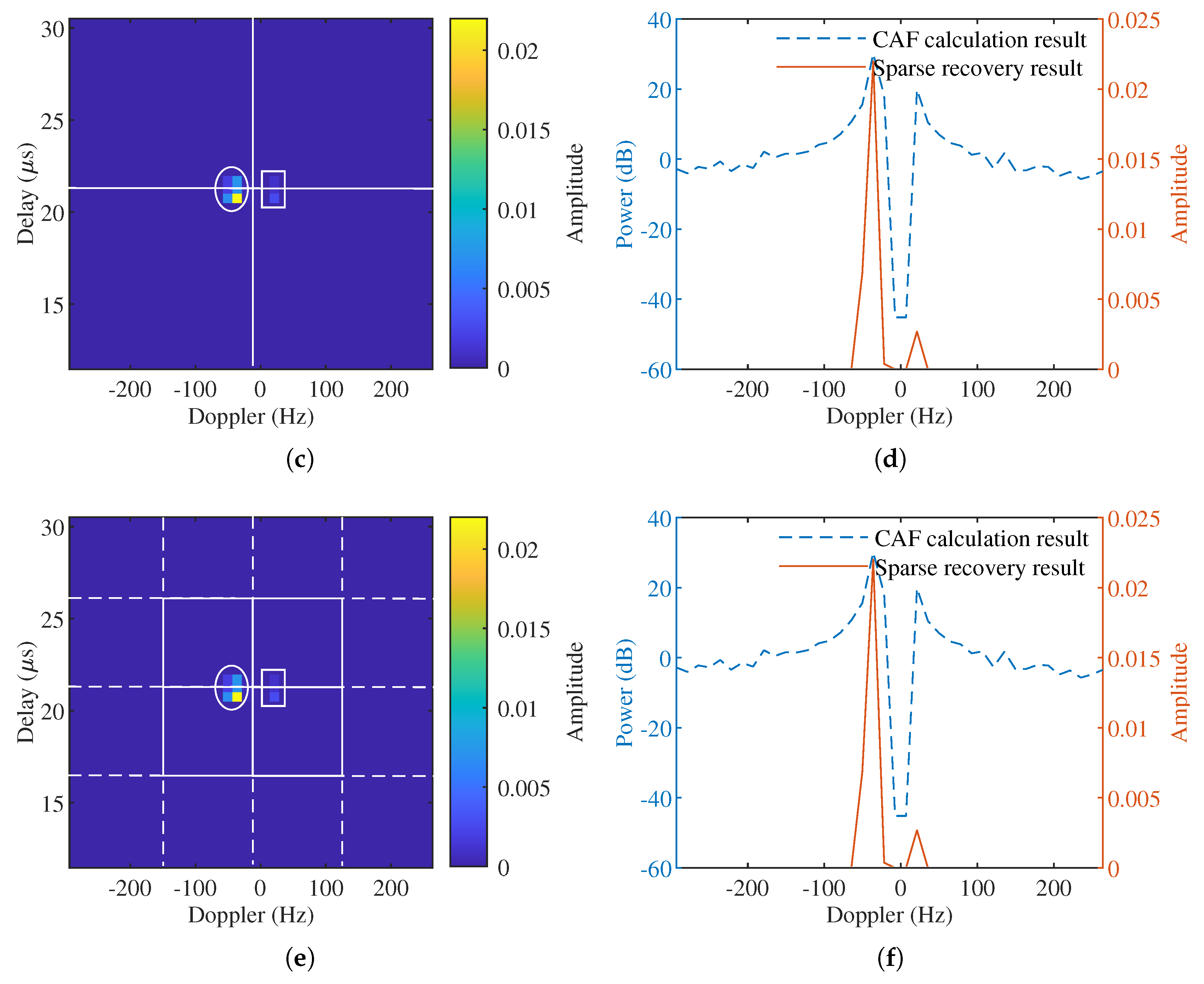

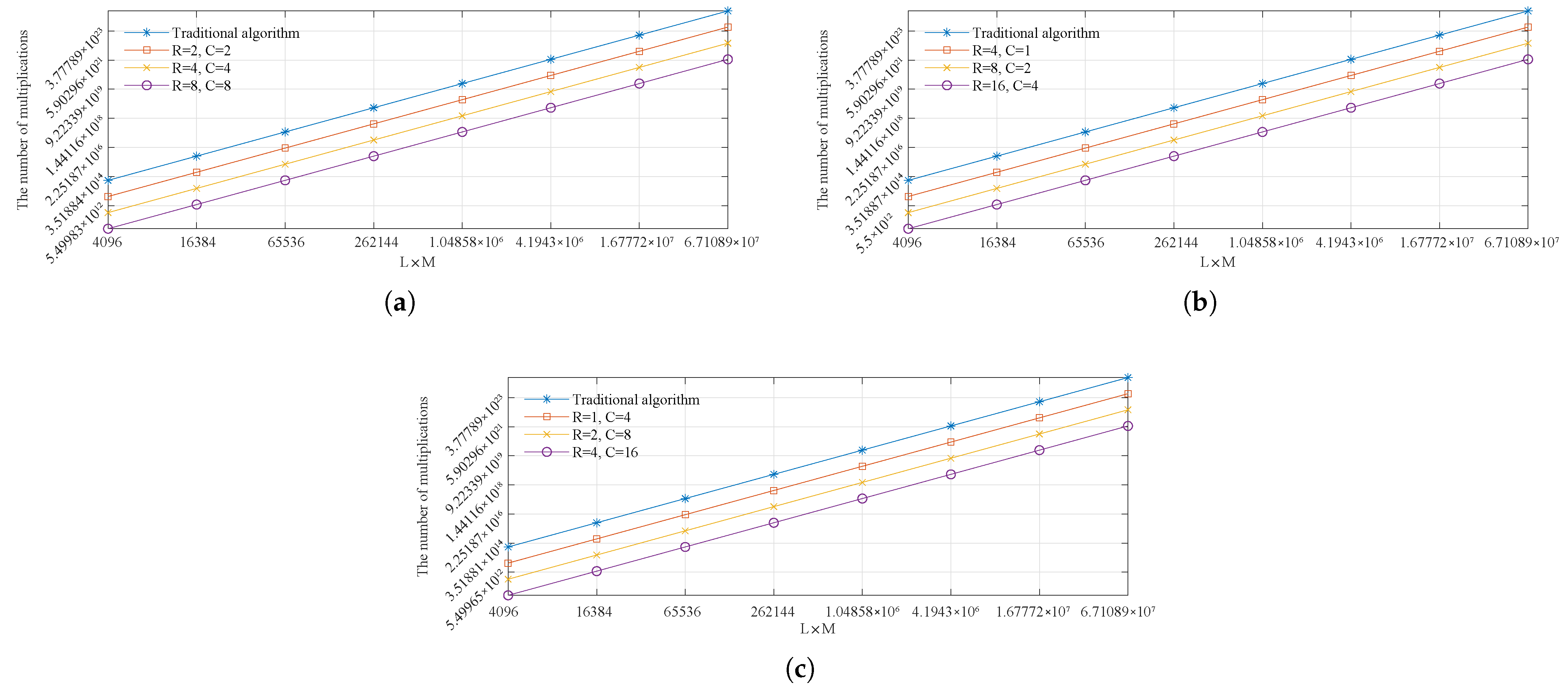
| Parameters | Values | Parameters | Values |
|---|---|---|---|
| Carrier frequency | 600 MHz | Target 1 RCS | 1 |
| Sample rate | 10 MHz | Target 2 RCS | 10 |
| Integration time | 0.25 s | Target 3 RCS | 5 |
| IO coordinate | (200 km, 0, 0.15 km) | Transmitter power | 1 kW |
| PBR coordinate | (0, 0, 5 m) | Transmitter gain | 12.5 dB |
| Target 1 coordinate | (80 km, 20.1 km, 9.9 km) | Receiver gain | 16 dB |
| Target 2 coordinate | (80 km, 20 km, 10 km) | Receiver bandwidth | 10 MHz |
| Target 3 coordinate | (100 km, −23 km, 10 km) | Receiver temperature | 298.15 K |
| Target 1 velocity | (45 m/s, 96 m/s, 0) | ||
| Target 2 velocity | (50 m/s, 80 m/s, 0) | ||
| Target 3 velocity | (70 m/s, 30 m/s, 0) |
Disclaimer/Publisher’s Note: The statements, opinions and data contained in all publications are solely those of the individual author(s) and contributor(s) and not of MDPI and/or the editor(s). MDPI and/or the editor(s) disclaim responsibility for any injury to people or property resulting from any ideas, methods, instructions or products referred to in the content. |
© 2024 by the authors. Licensee MDPI, Basel, Switzerland. This article is an open access article distributed under the terms and conditions of the Creative Commons Attribution (CC BY) license (https://creativecommons.org/licenses/by/4.0/).
Share and Cite
Cui, K.; Wang, C.; Zhou, F.; Liu, C.; Gao, Y.; Feng, W. Fast Algorithm of Passive Bistatic Radar Detection Based on Batches Processing of Sparse Representation and Recovery. Remote Sens. 2024, 16, 2294. https://doi.org/10.3390/rs16132294
Cui K, Wang C, Zhou F, Liu C, Gao Y, Feng W. Fast Algorithm of Passive Bistatic Radar Detection Based on Batches Processing of Sparse Representation and Recovery. Remote Sensing. 2024; 16(13):2294. https://doi.org/10.3390/rs16132294
Chicago/Turabian StyleCui, Kai, Changlong Wang, Feng Zhou, Chunheng Liu, Yongchan Gao, and Weike Feng. 2024. "Fast Algorithm of Passive Bistatic Radar Detection Based on Batches Processing of Sparse Representation and Recovery" Remote Sensing 16, no. 13: 2294. https://doi.org/10.3390/rs16132294
APA StyleCui, K., Wang, C., Zhou, F., Liu, C., Gao, Y., & Feng, W. (2024). Fast Algorithm of Passive Bistatic Radar Detection Based on Batches Processing of Sparse Representation and Recovery. Remote Sensing, 16(13), 2294. https://doi.org/10.3390/rs16132294






